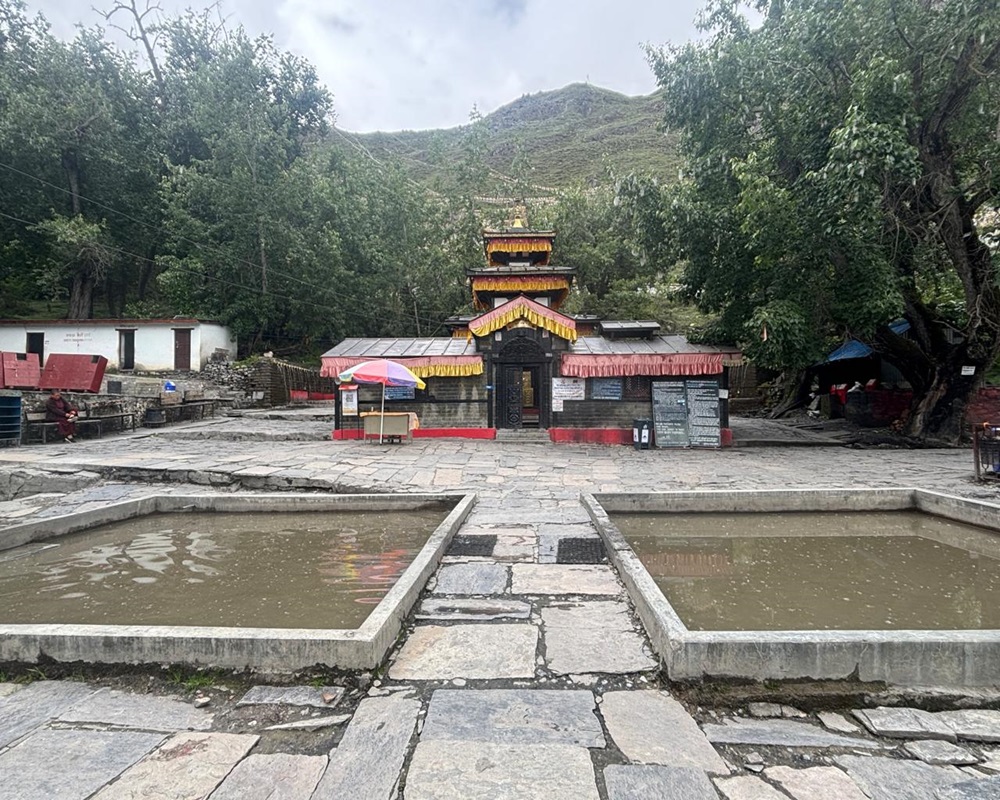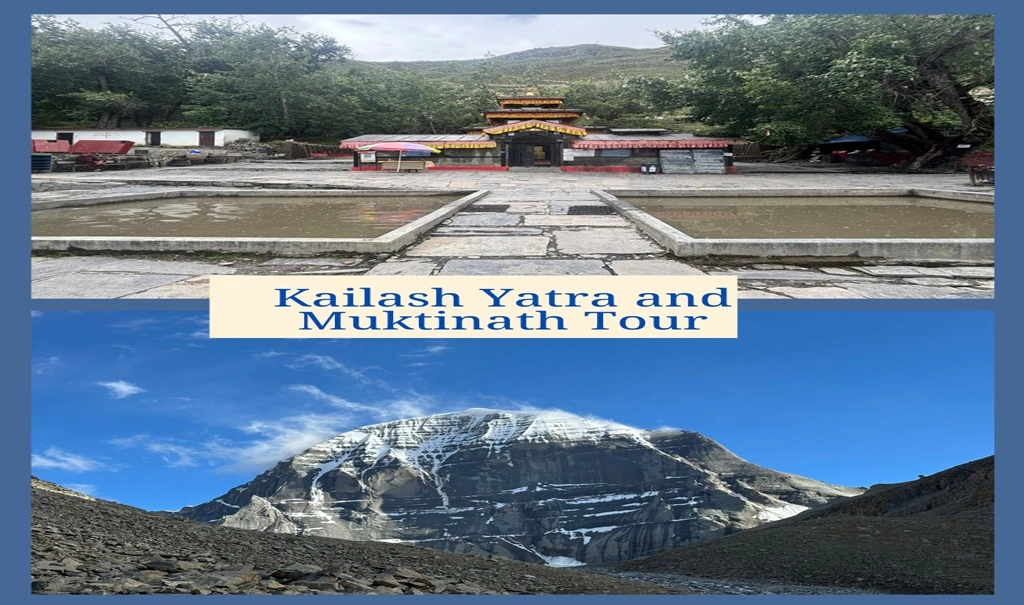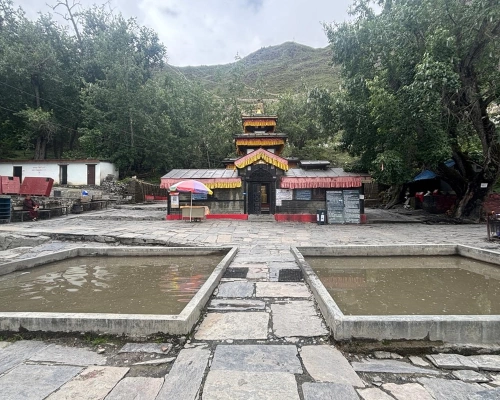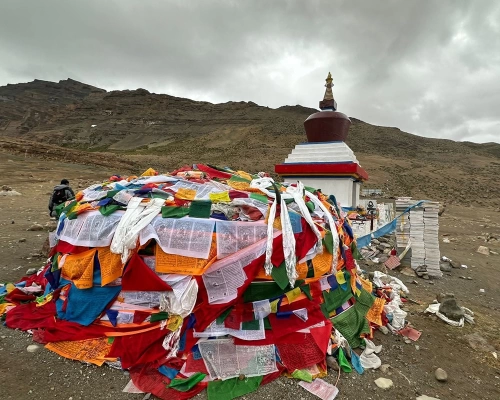About Kailash Mansarovar Yatra With Muktinath Darshan
The Kailash Mansarovar Yatra with Muktinath Darshan is a unique pilgrimage adventure set in breathtaking Himalayan scenery. This Kailash Muktinath Itinerary starts in Nepal and goes to Tibet, where the travellers meet the great Mt. Kailash, a mountain that Hindus and Buddhists believe to be home for Lord Shiva.
The journey to Kailash and to the nearby Lake Mansarovar is not only a physical trek; it is also an inward spiritual expedition made even more significant by glaciers, deep gorges, and worshipping peaceful holy lakes that give rise to a fulfilling inner journey.
The centre of this Kailash Yatra With Muktinath Temple Tour is Lake Mansarovar, often referred to as the highest freshwater lake known to man, as the lake is enclosed by snow-capped mountains. It's clear water encourages the believers to carry out various practices including bathing as part of rituals that remove all their sins.
This Kailash Region is also featured with awe-inspiring natural scenery that elevates the attractiveness of the area, two quite different effects being felt by the visitors—one harsh, typical of high altitude, and another, soft, quite the opposite. These landscapes, in addition to the opportunity to see various species of plants and animals, turn this trek into a very rich naturalistic expedition.
One more element to the mystical charm of this place is the Muktinath Temple, which is erected in the name of Lord Vishnu and is situated in the Annapurna mountains ranges. Muktinath is known as a place which is believed to provide moksha thus the place is revered by Hindus and Buddhists alike making it a colourful melting pot of various religions. The temple is presented with 108 water taps called Muktidhara and serves as a religious place where people can wash away, not only their dirt but also their negative energy.
In short, Muktinath and Kailash Parvat Pilgrimage Trip is not limited to the goal of reaching a certain place, rather it is aimed for a fulfilling experience aligned by fascinating shifts in culture and scenery. The sub-alpine vegetation, the rugged mountain passes, the breathtaking landscapes, and above all the diverse religious practices provide for a most unforgettable tour.
Highlights of Kailash Mansarovar Tour With Muktinath Temple Darshan
- Sightseeing in Pokhara, including boating Phewa Lake, exploring Tal Barahi Temple, Davis Falls, and World Peace Pagoda.
- Bathe at Tatopani [Natural Hot Springs], 4 hrs away from Pokhara.
- Engage in Muktinath Darshan and explore 108 holy taps and eternal flame.
- Explore high altitude lake, Mansarovar.
- Scenic views of Mount Kailash, which is believed to be the portrayal of Hindu God, Shiva, and involved in religious and cultural rituals.
Kailash Parvat Facts
- Elevation:Mount Kailash is 6,638 metres (21,778 feet) above sea level.
- Sacred status: Holy in four religions: Hinduism, Buddhism, Jainism, and Bon.
- Unclimbed peak: Mt.Kailash has never been officially climbed on account of its religious significance.
- Shape: The mountain is in the form of a pyramid, having four almost symmetrical faces.
- Water source: It's the source of four major Asian rivers: the Indus, Sutlej, Brahmaputra, and Karnali.
- Circumambulation Route: The 52-kilometre circuit of pilgrimage around the mountain is also called "kora" or "parikrama."
- Geologic Age: Some say it is 50 to 60 million years old; thus, in terms of geology, quite young.
- Visible from space: The details of Mt. Kailash-with its peculiar shape and isolation in its surroundings can even be viewed from outer space.
- Swastika Formation: On the southern face, there is a natural formation which looks similar to the sign of a swastika.
- Name origin: The Sanskrit name Kailash means "crystal", possibly because of the snow on its summit.
- Annual festival: Saga Dawa is celebrated at Mt. Kailash for Buddha's enlightenment, which happens every year.
More Information on Mount Kailash and Parikrama
Where is Kailash Mountain?
Kailash Mountain is located in the Kailash Range, which is part of the Trans Himalaya in the Tibet Autonomous Region of China. The mountain stands close to the town of Darchen in Ngari Prefecture and attains an altitude of 6,638 metres above sea level. The mountain is close to the sources of four of the longest rivers of Asia: the Indus River, Sutlej River, Brahmaputra River, and the Karnali River. Its remoteness in southwestern Tibet makes it one of the most inaccessible and difficult-to-reach locations. The nearest major city, Ali, is some 330 kilometres to the east. Though unclimbable, Mount Kailash draws in thousands of pilgrims and adventurers yearly because of its spiritual and natural interest.

Mount Kailash History
Ancient Origins and Spiritual Significance
Kailash Parvat is among the oldest mountains in the world and has been wrapped in thousands of years of history with spirituality and ancient traditions. It bears immense importance across many religions. Hinduism states it is the home to Lord Shiva, one of the most important gods in Hinduism. To Tibetan Buddhists, the mountain plays an important role in their cosmology. Apart from this, Mount Kailash is considered a sacred place by the indigenous Bon religion of Tibet, as well as by Jains, who link it with the enlightenment of their first Tirthankara. Probably because of this convergence of spiritual significance, Mount Kailash has become the focal point for pilgrims from various faiths. A tradition of circumambulation around the mountain, though better known as Kailash Parikrama or Kora, has been continuing for centuries and attracts devotees from all parts of the world who attempt this serious but spiritually rewarding journey.
Mythological Stories and Legends
History is embroidered richly in myths and legends about Mount Kailash, passed down through generations. In Hindu mythology, the mountain houses not only Lord Shiva but is where he performs the Tandava cosmic dance symbolic of the wheel of creation, preservation, and destruction. Yogic traditions speak of Kailash as a repository of spiritual energy, something like a big library of cosmic knowledge. Buddhist lore speaks of Milarepa, the most revered Tibetan yogis, as having ascended to the peak, riding on sunbeams. Jain scriptures speak about the mountain regarding the liberation of Rishabhadeva, their first Tirthankara. All these interlinked stories from various religions have joined together to give Kailash a reputation as a cosmic axis Mundi-a point where heaven meets earth.
Available Departure Dates for Kailash Mansarovar From India, US and any other countries For 2025
Month | Departure Dates | Status |
April | 6, 7, 8, 9, 10, 11, 12, 13, 14, 15, 16, 17, 18, 19, 20, 21 | |
May | 4, 5, 6, 7, 8, 9, 10, 11, 12, 13, 14, 15, 16, 17, 18, 19 | |
June | 1, 2, 3, 4, 5, 6, 7, 8, 9, 10, 11, 12, 13, 14, 15, 16 | |
July | 6, 7, 8, 9, 10, 11, 12, 13, 14, 15, 16, 17, 18, 19, 20, 21 | |
August | 3, 4, 5, 6, 7, 8, 9, 10, 11, 12, 13, 14, 15, 16, 17, 18 | |
August (2nd set) | 17, 18, 19, 20, 21, 22, 23, 24, 25, 26, 27, 28, 29, 30, 31 | |
September | 7, 8, 9, 10, 11, 12, 13, 14, 15, 16, 17, 18, 19, 20, 21, 22 | |
September (2nd set) | 14, 15, 16, 17, 18, 19, 20, 21, 22, 23, 24, 25, 26, 27, 28, 29 |
How To Go To Mount Kailash?
As Nepal acts as the stepping stone for any Kailash trip, you'll have to visit Nepal on the way to the holy mountain. Based on the basic Mount Kailash itinerary, it goes via Kerung and takes about 15 days or so in total. The itinerary of the route looks somewhat like what has been given below in a detailed view:
- Day 1: Arrival in Kathmandu and transfer to hotel
- Day 2: Early morning flight to Pokhara and drive to Tatopani (5-6 hours)
- Day 3: Tatopani to Muktinath for darshan & back to Jomsom (5-6 hours)
- Day 4: Jomsom to Pokhara (5-6 hours)
- Day 5: Pokhara sightseeing and flight back to Kathmandu
- Day 6: Drive to Kerung
- Day 7: Drive to Saga
- Day 8: Drive from Saga to Lake Mansarovar
- Day 9: Trek to Darchen
- Day 10: Trek to Zuthulphuk from Lake Mansarovar via Dolma La Pass
- Day 11: First day of Outer Kora – Trek to Dirapuk
- Day 12: Second day of Outer Kora – Onto Zuthulphuk
- Day 13: Drive to Kerung
- Day 14: Drive back to Kathmandu
- Day 15: Final departure
If you prefer only Kailash Parvat Darshan and Parikrima Tour or just Visit to Muktinath Temple then yopu can go though the Cost and Itinerary details of Kailash Mansarovar Yatra - 10 Days or Muktinath Temple Jeep Tour 8 Days.
Main Highlights Places and Things You Will Do Kailash Mansarovar Yatra With Muktinath Darshan
Mount Kailash
Mount Kailash is a holy Pyramid-shaped mountain at 6,638m revered by Hindus, Buddhists, Jains and Bons. Considered the dwelling place of Lord Shiva and the meditation spot of Milarepa. Devotees make the arduous kora around its base. There is Spiritual atmosphere with fantastic views of its north face.
Manasarovar Lake
A freshwater high-altitude lake of 4,550m altitude which to Hindus and Buddhists alike is a sacred lake. According to Hinduism, bathing and drinking its water purifies the soul. Monasteries with Mount Kailash views line the shores. For many pilgrims, a parikrama ritually circumnavigates by vehicle for about 90 km.
Muktinath Temple

A holy place for Hindus and Buddhists, it stands at 3,710m above sea level. There are 108 water spouts around the temple where devotees are allowed to perform ritual cleansing. It boasts of an eternal flame considered to be an embodiment of the goddess of fire, Jwala Mai. The panorama of the Annapurna range can also be viewed here. It is a combination of Hindu and Buddhist architecture and ways of life.
Pokhara
Pokhara is the adventure capital of Nepal. Phewa Lake with Annapurna range backdrop in all its serenity. Various temples, caves, and waterfalls surround Pokhara. The city is also the starting point of various treks in the Himalayas with Lively nightlife with a number of food options.
Kailash Parikrama
Three-day circumambulation of Mount Kailash: it is 52 kilometres long and crosses Dolma La Pass at 5,636 metres. This is spiritually a very important journey across holy sites and facing challenging terrains. It offers unique views of the sacred mountain and landscape around it.
Kailash Mansarovar Yatra With Muktinath Darshan Cost
- 1 Person: $3800, Per Person
- 2 People: $3650 per person
- 3-5 People: $3300 per person
- 6-10 People: $2850 per person
For the breakdown of the Kailash Yatra Cost go though our blog "Kailash Mansarovar Tour Cost"
China Visa -Free Countries List (For 30 Days)
Visa-free entry into China is now available for citizens of select countries for up to 30 days. For citizens of these countries, the permits and visas required are issued very quickly and easily; you only need to arrive in Kathmandu, and within a day, you are ready to start your Kailash journey without long waiting periods. This visa-free system is valid from November 30, 2024, to December 25, 2025. However, citizens of countries not listed below must expect a processing time of 4–5 days upon arrival in Kathmandu for their permits and visas. Make sure to plan accordingly. Below are the names of the countries eligible for China Visa -Free pass.
- Andorra
Australia
Austria
Belgium
Brunei
Bulgaria
Croatia
Cyprus
Denmark
Estonia
Finland
France
Germany
Greece
Hungary
Iceland
Ireland
Italy
Japan
Latvia
Liechtenstein
Luxembourg
Malaysia
Malta
Monaco
Montenegro
Netherlands
New Zealands
North Macedonia
Norway
Poland
Portugal
Romania
Slovakia
Slovenia
South Korea
Spain
Switzerland









